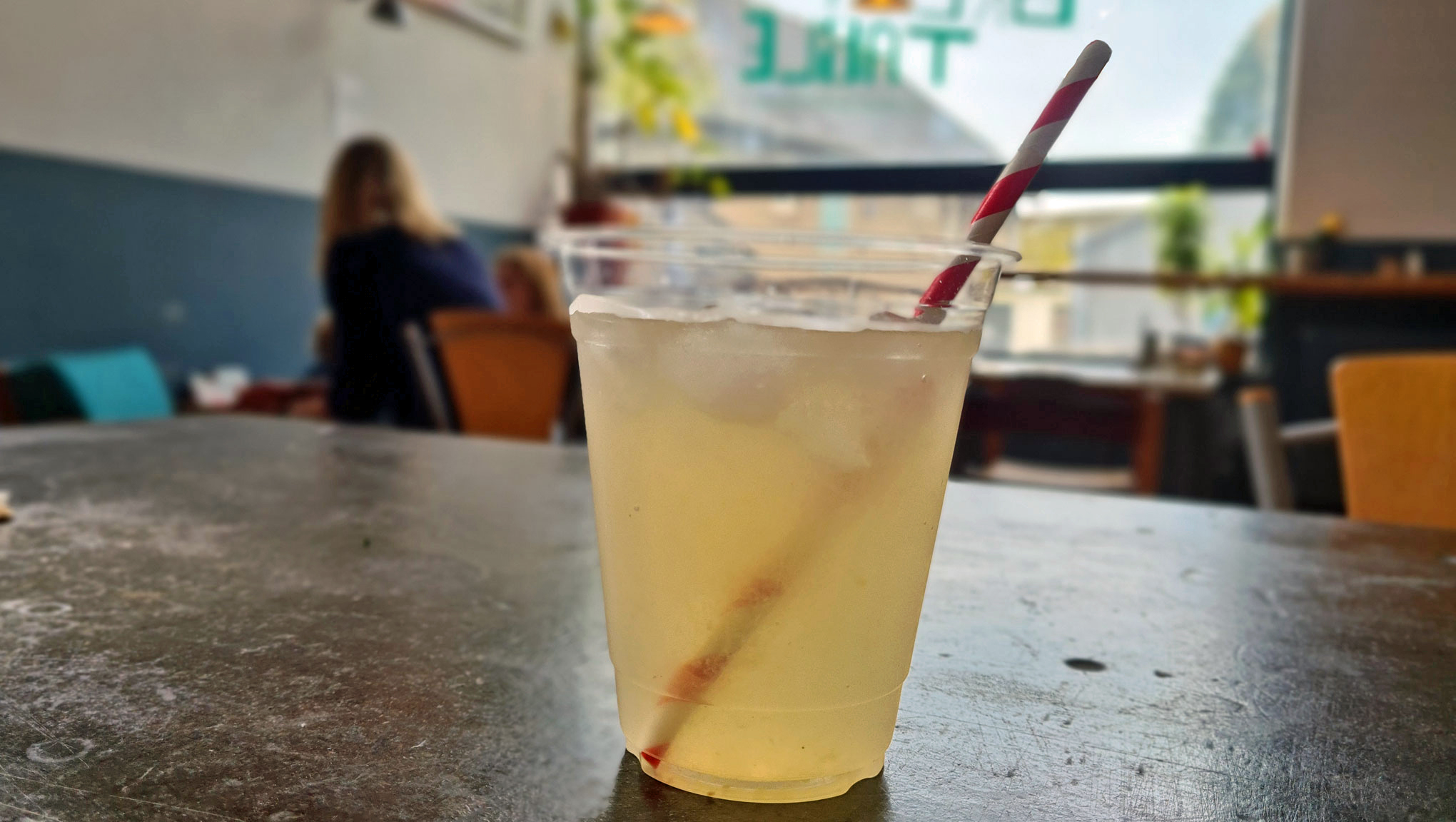
Tara Vaughan-Hughes
Tara, the Food Strategy Lead for Dartington, links our food areas across the estate (retail, pub, cafe, and higher learning) to create and maintain a sustainable food system that aligns with our current and future aspirations.
It’s not plastic, it’s fantastic!
One of the things we do around here is continually look at our sustainability practices and update them as necessary. In fact, if we didn’t do this, it would be noted by our loyal customers and the students and staff at Schumacher College. They all encourage us to be our best selves in every way.
So, amongst this constant scrutiny and revision, we’ve been patting ourselves on the back with our sustainable policies in the Green Table, the White Hart, and the Schumacher College kitchens. We’ve always bought recycled/recyclable, and in the past few years, with new technology around plant based packaging, we can finally say we’ve nailed the disposables, specifically the takeaway containers and cutlery.
For the sandwiches, salads, and other food stuffs, we use bagasse clamshell boxes. Bagasse is the fibre which is left over after extracting juice from sugar cane. Because it is a waste product, it is highly sustainable as long as the sugar industry is healthy. Containers made with bagasse look a tiny bit like the Styrofoam containers of the past, but with a feel of rough paper.
(Here’s an interesting fact: bagasse is often used to help with intestinal regularity, and studies have show that the addition of bagasse to a diet may help with Type 2 diabetes. So it’s entirely possible that, as you scrape down to the last bite in your bagasse container, you might be getting a little health benefit!)

For our takeaway lemonade, iced tea and iced coffee, we use Vegware’s cold drinks cups made from PLA. PLA, which is short for Polylactic Acid, is made from plants — usually corn, cassava, sugar cane, or sugar beet pulp. PLA is is also a component of the Vegware CPLA cutlery, which we use as well. (The ‘C’ stands for Crystallised.)
The cups look like clear plastic cups, and the cutlery looks like off-white plastic. Because of this, we often get customers chastising us for using plastic. We finally wised up and put some signs near the containers, but as we know, not everyone reads signs, so we still need to tell people about the eco-friendly qualities of the items in question. (This is partly why I write this blog, so you know what we’re up to.)
Enough with the science already.
Okay, I agree. The main thing is that we are doing the right thing with regard to our purchasing. No fossil fuel plastics here, just eco-friendly goods.
So let’s move on to what happens next.
All of vegware’s containers are compostable in an industrial facility. So you need to put them in the compost bin of your local council and not in your compost heap.
That sounds easy enough!
It is extremely easy, and we’ve been pretty diligent about making sure all our compostables are put in with the food waste, which then gets taken to an industrial facility. Sometimes other things (cling film, blue roll, aluminium foil) get in there. I always try to take these things out, and I’ve been very vocal with staff about not contaminating the compost. This is because I had been told previously that irretrievably mixed waste goes straight to an incinerator.
But just to be sure that we were getting it right, I had a little chat with Gary, the Technical Director at Langage Farm. Langage has an Anaerobic Digesting facility. This enables them to take the food waste from our rubbish contractor and turn it into energy as well as a biofertiliser that can be put on the fields to help grow the grass which feeds the cows. That’s a great loop.

The UK throws away about 9.5 million tonnes of food per year. Based on calculations from the Energy Saving Trust, if we treated all of that food waste like this, we could generate enough energy to serve almost a quarter of a million households.
This is all good news! Even though the food waste is not actually composted, it is being turned into new resources. There’s just one problem.
According to Gary, the 100% compostable disposables that we put in with the food waste get removed, and they are put into an incinerator.
Wait, an incinerator?!
Yes. The AD is a digesting facility, not a composting facility. That means that our compostables, which we have faithfully been adding to the food bins, are contaminating the food waste and have to be removed before the anaerobic digestion can begin. The incinerator then burns these and other materials that would otherwise go to landfill, and the result is energy that provides heating and electricity.
Fortunately, incinerators have come a long way since I was a girl; we’re not talking massive smokestacks belching out toxic black fumes. There are emission controls that keep airborne particles from entering the atmosphere, and there are ways to separate precious metals for re-use.
However, the average efficiency of producing energy this way is 22%, which to be honest, is pretty low. (Even coal has an energy efficiency of 29%, but luckily, renewable sources can beat that; solar is at 207%, and wind comes in at 1164%.) So incineration is not about to take over as an alternative to other energy sources. But it is a marginal boost to our energy grid, and it keeps waste from going to landfill and creating methane.
Who knows how long this technology will be relevant. The EU has started to stop funding waste-to-energy incinerators, stating that making energy this way
“…opposes the transition towards a carbon-neutral and circular economy. Instead, higher environmental performance waste management solutions that embrace the zero waste goal, such as waste prevention, reuse and recycling are now encouraged and being financed.“ – Zero Waste Europe
As goes Europe, so goes Britain, or at least it used to be that way. So we may or may not keep incinerating our waste and use it as a small percentage of energy.
Um, wasn’t this supposed to be about plastic?
Well, yes, the whole point of this was to show how Dartington is working toward being as sustainable as possible. But all of a sudden, the ground seems to have shifted under our feet. In my conversation with Gary, when I realised that nothing – absolutely nothing – was being composted, I exclaimed, “We keep trying to do the right thing, but it keeps changing!’
Gary sagely said, ‘The right thing hasn’t changed, but the information keeps changing.’
I suppose he’s right.
So we need to keep on doing our research, and – in the spirit of the Elmhirsts – to keep on adopting what seems to be the best practice given the information we have at hand.
For our disposables, that means we will continue to use the Vegware, knowing that the materials are the best sustainable choice at the moment. But when we dispose of them, we will be sure to add them to our mixed rubbish, to head to the incinerator.
We will now keep our food waste unadulterated with anything other than, erm, food waste. And at some point, we will be composting that. But that’s a whole different story…
Sources:
https://energysavingtrust.org.uk/generating-energy-waste-how-it-works/
https://waste-management-world.com/artikel/waste-to-energy-the-carbon-perspective/
https://zerowasteeurope.eu/2021/05/wte-incineration-no-place-sustainability-agenda/
